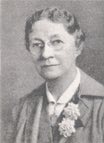Today’s supermarket refrigerated and frozen food sections are the direct result of the pioneering work of Dr. Mary Engle Pennington. As the population of the United States moved to cities, and people turned to stores and foods shipped long distances instead of backyard home gardens, the 1906 Pure Food and Drug Act was passed to secure the food supply. Dr. Pennington was a trailblazer in implementation of the Act, overseeing the handling, transportation and storage of perishables. She became a leading expert in the evolution of safe and sanitary methods for processing, storing and shipping milk, poultry, eggs, and fish.
Denied a bachelor’s degree in 1892 because of her gender, Mary Engle Pennington received a certificate of proficiency in chemistry and then went on to earn her PhD in chemistry at the same institution, the University of Pennsylvania, in 1895. She founded the Philadelphia Clinical Laboratory in 1898, joined the U.S. Department of Agriculture in 1905 and became the Chief of its Food Research Lab in 1908. She did bacteriological analyses for subscribing doctors and developed milk and dairy standards, including checklist procedures for dairy herds that were adopted throughout the United States. She traveled the nation investigating the efficiency of refrigerator cars and recommended standards for construction and insulation.
A recognized authority on refrigeration and its effect on food products, Dr. Mary Engle Pennington spent more than forty years educating the government and the general public in the techniques and importance of proper handling of perishable food. In her later years she oversaw the design and construction of modern refrigerated warehouses, commercial and home refrigerators.
In 1923, Pennington was recognized by the American Society of Heating, Refrigeration and Air-conditioning Engineers (ASHRAE), as the foremost American authority on home refrigeration. She was profiled by the New Yorker as “Ice Woman” in 1941, was the first woman elected to the Poultry Historical Society Hall of Fame (1959), and was elected fellow by the American Society of Refrigerating Engineers in 1947.

